We witness the everyday fight for our planet, so finding ways to reduce carbon emissions should be one of the priorities of humankind. According to the UN Global Status Report for Buildings and Construction, this industry created 37% of global energy-related CO2 emissions in 2020 which is only 1 percent less than in 2019. While this is not a number that can be lowered quickly, some things we can still do to reduce it by more than just one percent in the following years.
Let’s discuss home building materials you can repurpose, whether you send them to recycling after renovations or reuse it to renovate.
Bricks
One of the most commonly used materials in construction is brick. Once a building standard, not it gives the vintage appeal to a house exterior or a sophisticated look to your home’s interior. If you have a brick set aside to throw away, think about how you can repurpose it. For example, you can place it around the fireplace or use it for an accent wall.
If you don’t see bricks fitting into your plans, organize a yard sale or give an ad to find potential buyers. They may have been used in the garden as decoration or walls, even turning them into steps or pathways is a good way to reuse your old brick. This is an especially good idea if you have broken bricks to create rustic arrangements that will give your home character and enhance curb appeal.
Drywall
Considering that drywall consists of two sheets of paper with gypsum between them, you won’t have any problem recycling it. Based on Ohio State University data, drywall makes up 25% of total construction waste in the USA which is not surprising since it’s commonly used for interior construction.
Besides sending it to a recycling facility, you can use it right on the spot, for example, as pieces to fill in the holes in the wall. It’s good for your garden because it contains boron and when mixed into the soil it turns into a plant nutrient. Some homeowners use paper from the drywall for compost that will serve as fertilizer when ready.
Copper roofing
New copper roofing is mostly made from recycled copper. Being durable gives it an advantage over other metals that corrode faster since people want quality building materials that last a long time. If you look at the rooftops of old buildings or monuments, like the Statue of Liberty, you will notice their gray-green hue. This is because when exposed to the atmosphere, copper creates a patina that is considerably corrosion-resistant.
If you have old copper wiring, roof, plumbing pipes, and other scraps, you can sell them to specialized recycling companies and earn money. Moreover, choosing to install copper roofing is sustainable, cost-effective, and will protect your home for decades, even centuries. It’s also environmentally friendly since the copper rarely ends up in landfills and almost all of it is recycled and repurposed, particularly in the building industry.
Wooden materials
Wood is often repurposed because carpenters can turn most of it into something new. The rest can go to grinders that will turn waste wood into particleboards. Carpenters can turn old wood into doors, floors, panels, windows, staircases, walls, and anything else that is necessary. Moreover, you can use it to build a fence and a gate for the property, or maybe even a deck, patio, or pergola for the backyard.
One of the trending styles in interior design is using old beams as decorations on the wall and ceiling to give the home an old-fashioned charm. Just for highlighting its importance, 6,000 feet of wooden boards can save 33 trees from being cut down, as well as water and power necessary for the manufacturing process.
Concrete
Recycling and reusing concrete saves millions of dollars for construction companies today, while in the past it was transported to landfills. When you pile up all the concrete rubble, you can sell it to a crushing center or have your workers turn it into dust at the site.
This finely crushed concrete is a great material to pave a driveway, walkways, steps, and other parts of the landscape. Some builders use this concrete dust to create a foundation for utilities and installations, like water and sewer pipes. Those creative, like landscape designers, can use the concrete rubble to create layers in the uneven terrain or for other decorative purposes.
The bottom line
You have options when it comes to building materials you can repurpose and it all depends on what kind of renovations you are doing. Sometimes, you may just need to move around materials, while in other cases you may have to send them to a recycling facility. Both scenarios use fewer resources than it would take to produce new materials, and that is good for sustainability.




